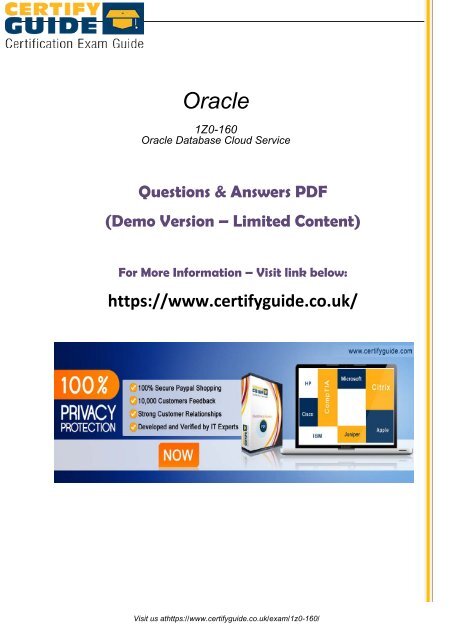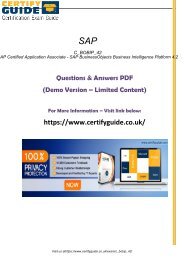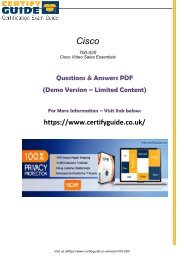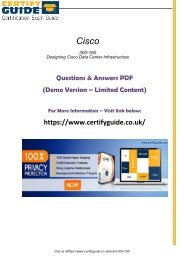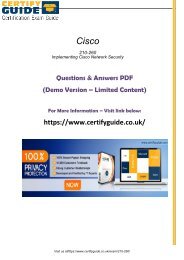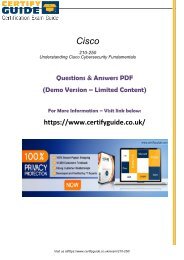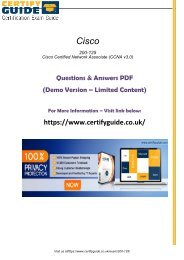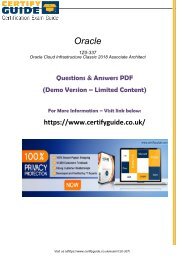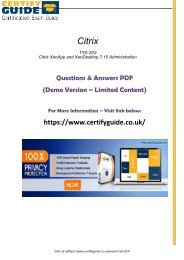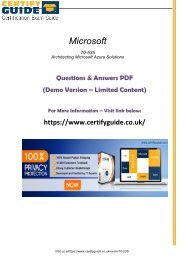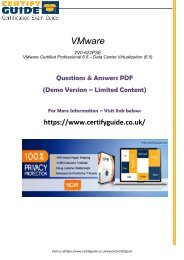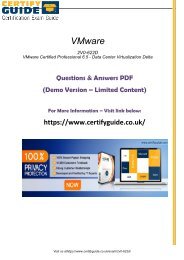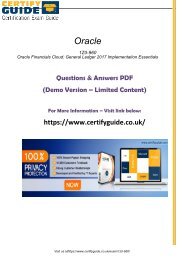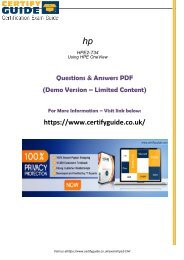1Z0-160 Exam Training 2018
CertifyGuide.co.uk offers the coveted quality benchmarks and along these lines think of preparing guides that makes the items the most favored ones among the business experts. We are IT Accreditation specialists, helping the confirmation exam applicants around the world. We give adaptability, prep up your aptitudes and honor yourself with authority of our picked field. Click the link below to get Full Version: https://www.certifyguide.co.uk/exam/1Z0-160/
CertifyGuide.co.uk offers the coveted quality benchmarks and along these lines think of preparing guides that makes the items the most favored ones among the business experts. We are IT Accreditation specialists, helping the confirmation exam applicants around the world. We give adaptability, prep up your aptitudes and honor yourself with authority of our picked field. Click the link below to get Full Version: https://www.certifyguide.co.uk/exam/1Z0-160/
You also want an ePaper? Increase the reach of your titles
YUMPU automatically turns print PDFs into web optimized ePapers that Google loves.
Oracle<br />
<strong>1Z0</strong>-<strong>160</strong><br />
Oracle Database Cloud Service<br />
Questions & Answers PDF<br />
(Demo Version – Limited Content)<br />
For More Information – Visit link below:<br />
https://www.certifyguide.co.uk/<br />
Visit us athttps://www.certifyguide.co.uk/exam/1z0-<strong>160</strong>/
Question: 1<br />
You want all your colleagues to be able to access the compute node associated with an Oracle Database<br />
Cloud – Database as a Service (DBaaS) instance. You want them to do so by using a custom host name<br />
rather than an IP address regardless of the client machine (personal or provided by the company) that<br />
they use for the access.<br />
How would you enable this access?<br />
A. Configure the Advanced Security Option (ASO).<br />
B. Enable secure access to the DBaaS instance VM and database instance from remote hosts by using<br />
SSH.<br />
C. Contact the administrator of your company’s intranet DNS and request a custom DNS record for the<br />
compute node’s public IP address.<br />
D. Edit the machine’s/etc/hostsfile.<br />
E. Resolve your domain name to the IP address of the DBaaS compute node by using the third-party<br />
domain registration vendor console.<br />
Answer: C<br />
Explanation:<br />
You can associate a custom host name or domain name to the public IP address of a compute node<br />
associated with your Oracle Database Cloud Service environment.<br />
To associate a custom host name to the public IP address of a compute node, contact the administrator<br />
of your DNS (Domain Name Service) and request a custom DNS record for the compute node’s public IP<br />
address. For example, if your domain is example.com and you wanted to use clouddb1 as the custom<br />
host name for a compute node, you would request a DNS record that associates clouddb1.example.com<br />
to your compute node's public IP address.<br />
References:<br />
https://docs.oracle.com/en/cloud/paas/database-dbaas-cloud/csdbi/define-custom-host-or-domainname.html<br />
Question: 2<br />
With Oracle Database Cloud Service as the subscription type, you must configure a database for Backup<br />
and Recovery.<br />
Which two options do you have to back up your database instance?<br />
A. No backups required. You are responsible for configuring the database backups.<br />
B. Backup to cloud storage and VM block storage. Ten days worth of backups are kept, with five most<br />
recent days worth of backups available directly on VM block storage.<br />
C. Backup to Oracle Cloud Service storage volumes that is equal to five times the value that was<br />
provided in Usable Data Storage when the instance was created.<br />
D. Backup to cloud storage and VM block storage. Fourteen days worth of backups arekept, with seven<br />
most recent days worth of backups available directly on VM block storage.<br />
Visit us athttps://www.certifyguide.co.uk/exam/1z0-<strong>160</strong>/
Answer: A,D<br />
Explanation:<br />
When creating a new database deployment on Oracle Database Cloud Service, you choose whether you<br />
want automatic backups to be configured for the database. Your choices are:<br />
Both Cloud Storage and Local Storage—30 days' worth of backups are kept, with the 7 most recent days'<br />
worth available directly on the compute node’s local storage.<br />
Cloud Storage Only—30 days' worth of backups are kept, with all backupson cloud storage.<br />
None—automatic backups are not configured.<br />
References:<br />
https://docs.oracle.com/en/cloud/paas/database-dbaas-cloud/csdbi/db-deployments.html<br />
Question: 3<br />
Users must be granted roles to manage Cloud services.<br />
Which three statements are true about roles and role assignment in Database as a Service (DBaaS)?<br />
A. Service administrators can assign and remove roles only for users of theservices that they manage.<br />
B. The DBaaS Database Administrator role permits granting the DBaaS Database Administrator or DBaaS<br />
Database Operator role to existing users.<br />
C. Identity domain administrators can assign and remove roles for users in any identitydomains.<br />
D. The DBaaS Database Operator role permits the ability to scale, patch, and backup or restore service<br />
instances.<br />
E. DBaaS network administrators can grant access privileges to designated users.<br />
Answer: ABD<br />
Explanation:<br />
A: A Service administrator manages administrative functions related to Oracle Cloud services within an<br />
identity domain.<br />
D: The privileges given to the DBaaS Database Administrator role include:<br />
Can scale, patch, and back up or restore database deployments<br />
Question: 4<br />
Which users are created and can be used for database and host management of your DBaaS database<br />
servers?<br />
A. root,opcandoracleusers<br />
B. root,oracleandcloudusers<br />
C. rootandoracleusers<br />
D. opcandoracleusers<br />
E. cloudandoracleusers<br />
Visit us athttps://www.certifyguide.co.uk/exam/1z0-<strong>160</strong>/
Answer: D<br />
Explanation:<br />
Linux user accounts that are provisioned on an Oracle Database Cloud Service deployment that hosts an<br />
Oracle Real Application Clusters (Oracle RAC) database:<br />
* opc<br />
The system administrator account you use to connect to the compute node using SSH. This user can use<br />
the sudo command to perform operations that require root-user access.<br />
* oracle<br />
The Oracle Database administrator account you use to access the system and perform non-root<br />
database administration tasks.<br />
* grid<br />
The Oracle Grid Infrastructure administrator account you use to perform ASM, ACFS, and clusterware<br />
administration tasks.<br />
* root<br />
The root administrator for the system. You do not have direct access to this account. To perform<br />
operations that require root-user access, use the sudo command as the opc user.<br />
References:<br />
https://docs.oracle.com/en/cloud/paas/database-dbaas-cloud/csdbi/linux-user-accounts-rac.html<br />
Question: 5<br />
Which two situations require that your Database as a Service (DBaaS) instance be scaled up?<br />
A. The DBaaS instance is maxed out on semaphore sets.<br />
B. The database instance has reached the limit in thelicense_max_sessionsdatabase parameter.<br />
C. The DBaaS instance is maxed out on CPU.<br />
D. The database instance is out of space in the sysaux and system tablespaces.<br />
E. The DBaaS instance is maxed out on storage.<br />
F. The DBaaS instance is maxed out on semaphores.<br />
Answer: C,E<br />
Explanation:<br />
Existing DBCS instances may scale up to bigger shapes in OCPU, Memory and Storage for vertical scaling.<br />
For horizontal scaling, DBCS provides RAC with the Extreme Performance option currently allowing<br />
applications to scale up to 2 nodes, each with a max of 16OCPU shapes.<br />
Note: An Oracle CPU (OCPU) provides CPU capacity equivalent of one physical core of an Intel Xeon<br />
processor with hyper threading enabled. Each OCPU corresponds to two hardware execution threads,<br />
known as vCPUs.<br />
References:<br />
https://cloud.oracle.com/opc/database/faq<br />
Visit us athttps://www.certifyguide.co.uk/exam/1z0-<strong>160</strong>/
Question: 6<br />
How would you enable a port persistently to keep communication open through that port always?<br />
A. To enable a port persistently, you must contact your DBaaS support team to update the port<br />
specifications for use.<br />
B. You can use server certificates to map a server’s identity to enable persistent connection through a<br />
port to DBaaS instances.<br />
C. All ports that are available in DBaaS servers must use an SSH tunnel and cannot be enabled<br />
persistently.<br />
D. To enable a port persistently, you would require access to the Compute Cloud Service Console to<br />
open the ports to a set of IP addresses.<br />
Question: 7<br />
Answer: D<br />
dbaascli is a command-line interface for managing a database instance on cloud.<br />
Which two functions can you manage with dbaascli?<br />
A. running health checks on your database<br />
B. creating users in the database instance<br />
C. restoring fromthe most recent backup<br />
D. creating a database instance<br />
E. applying a patch<br />
Answer: C,E<br />
Explanation:<br />
The dbaascli utility is provided on Oracle Database Cloud Service deployments to perform a variety of<br />
life-cycle and administration operations.<br />
Using the dbaascli utility, you can perform operations like:<br />
*Database recovery<br />
The orec latest subcommand restores the most recent backup and performs complete recovery.<br />
*Patching the database deployment<br />
Thedbpatchmapplysubcommandapplies the patch.<br />
*Changing the password of the SYS user<br />
*Checking the status of the Oracle Data Guard configuration<br />
*Switchover and failover in an Oracle Data Guard configuration<br />
*Rotating the master encryption key<br />
References:<br />
https://docs.oracle.com/en/cloud/paas/database-dbaas-cloud/csdbi/dbaascli.html<br />
Visit us athttps://www.certifyguide.co.uk/exam/1z0-<strong>160</strong>/
Powered by TCPDF (www.tcpdf.org)<br />
For More Information – Visit link below:<br />
https://www.certifyguide.co.uk/<br />
Thanks for Using Our Product<br />
Use coupon code “20off<strong>2018</strong>” for 20% discount<br />
Visit us athttps://www.certifyguide.co.uk/exam/1z0-<strong>160</strong>/


